12.5: Conic Sections in Polar Coordinates
( \newcommand{\kernel}{\mathrm{null}\,}\)
- Identify a conic in polar form.
- Graph the polar equations of conics.
- Define conics in terms of a focus and a directrix.
Most of us are familiar with orbital motion, such as the motion of a planet around the sun or an electron around an atomic nucleus. Within the planetary system, orbits of planets, asteroids, and comets around a larger celestial body are often elliptical. Comets, however, may take on a parabolic or hyperbolic orbit instead. And, in reality, the characteristics of the planets’ orbits may vary over time. Each orbit is tied to the location of the celestial body being orbited and the distance and direction of the planet or other object from that body. As a result, we tend to use polar coordinates to represent these orbits.

In an elliptical orbit, the periapsis is the point at which the two objects are closest, and the apoapsis is the point at which they are farthest apart. Generally, the velocity of the orbiting body tends to increase as it approaches the periapsis and decrease as it approaches the apoapsis. Some objects reach an escape velocity, which results in an infinite orbit. These bodies exhibit either a parabolic or a hyperbolic orbit about a body; the orbiting body breaks free of the celestial body’s gravitational pull and fires off into space. Each of these orbits can be modeled by a conic section in the polar coordinate system.
Identifying a Conic in Polar Form
Any conic may be determined by three characteristics: a single focus, a fixed line called the directrix, and the ratio of the distances of each to a point on the graph. Consider the parabola
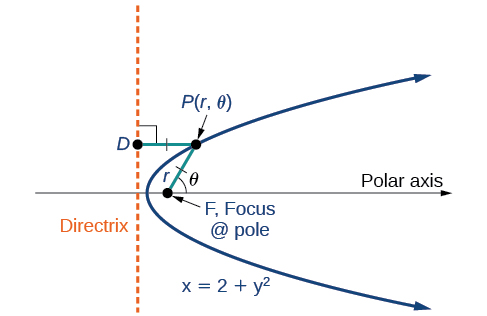
We previously learned how a parabola is defined by the focus (a fixed point) and the directrix (a fixed line). In this section, we will learn how to define any conic in the polar coordinate system in terms of a fixed point, the focus
If
For a conic with eccentricity
- if
- if
- if
With this definition, we may now define a conic in terms of the directrix,
For a conic with a focus at the origin, if the directrix is
For a conic with a focus at the origin, if the directrix is
- Multiply the numerator and denominator by the reciprocal of the constant in the denominator to rewrite the equation in standard form.
- Identify the eccentricity
- Compare
- Determine the directrix as
For each of the following equations, identify the conic with focus at the origin, the directrix, and the eccentricity.
Solution
For each of the three conics, we will rewrite the equation in standard form. Standard form has a
- Multiply the numerator and denominator by
Because
Since
- Multiply the numerator and denominator by
Because
Since
- Multiply the numerator and denominator by
Because sine is in the denominator, the directrix is
Because
Identify the conic with focus at the origin, the directrix, and the eccentricity for
- Answer
-
ellipse;
Graphing the Polar Equations of Conics
When graphing in Cartesian coordinates, each conic section has a unique equation. This is not the case when graphing in polar coordinates. We must use the eccentricity of a conic section to determine which type of curve to graph, and then determine its specific characteristics. The first step is to rewrite the conic in standard form as we have done in the previous example. In other words, we need to rewrite the equation so that the denominator begins with
Graph
Solution
First, we rewrite the conic in standard form by multiplying the numerator and denominator by the reciprocal of
Because
The directrix is
Plotting a few key points as in Table
| A | B | C | D | |
|---|---|---|---|---|
| undefined |
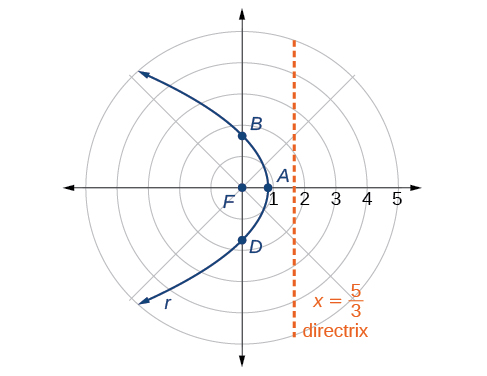
We can check our result with a graphing utility. See Figure

Graph
Solution
First, we rewrite the conic in standard form by multiplying the numerator and denominator by the reciprocal of
Because
The directrix is
Plotting a few key points as in Table
| A | B | C | D | |
|---|---|---|---|---|
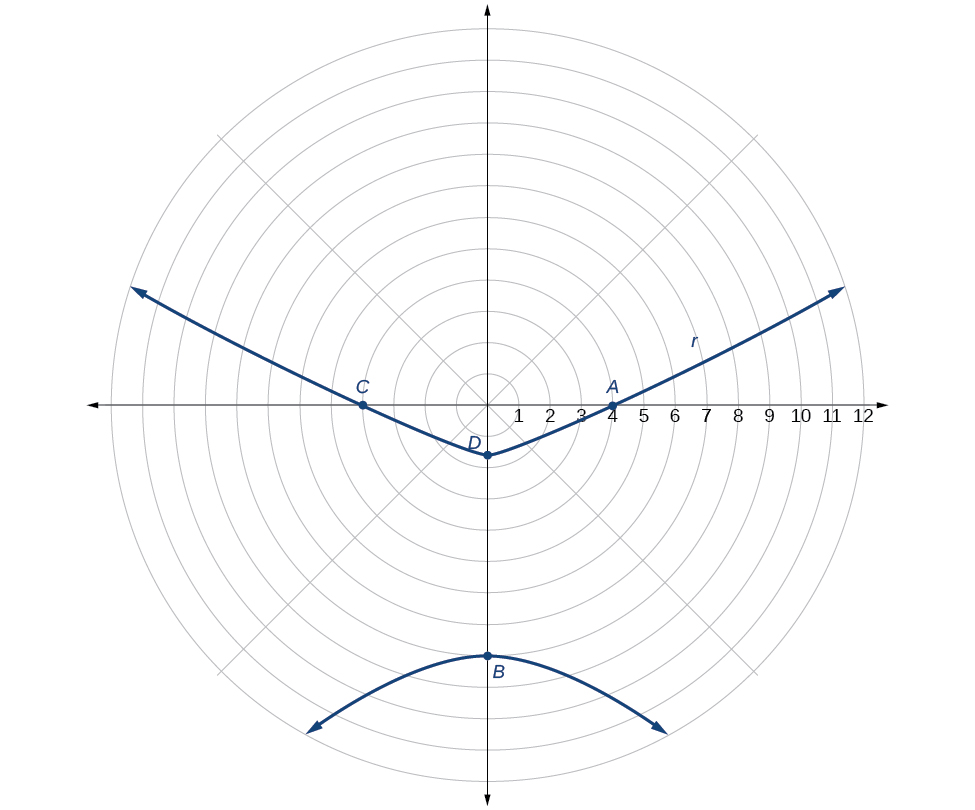
Graph
Solution
First, we rewrite the conic in standard form by multiplying the numerator and denominator by the reciprocal of 5, which is
Because
The directrix is
Plotting a few key points as in Table
| A | B | C | D | |
|---|---|---|---|---|
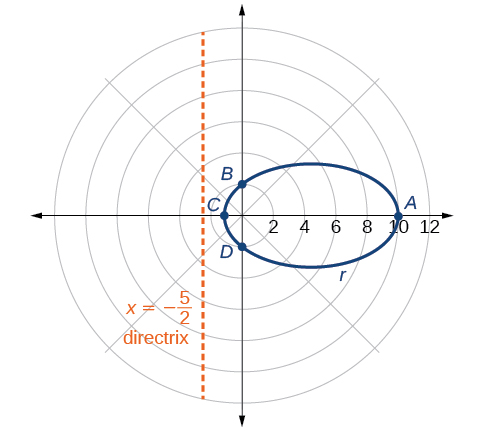
Analysis
We can check our result using a graphing utility. See Figure
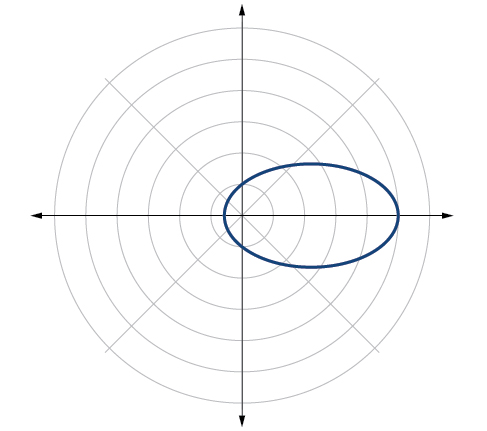
Graph
- Answer
-
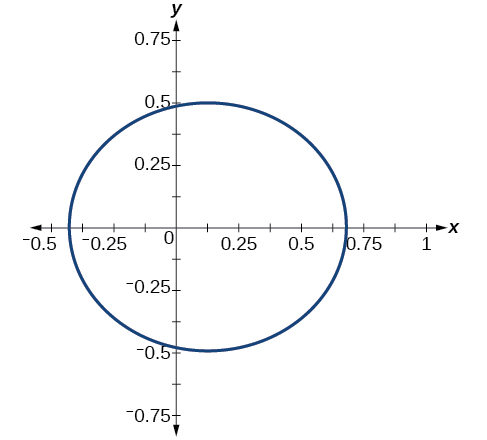
Figure
Defining Conics in Terms of a Focus and a Directrix
So far we have been using polar equations of conics to describe and graph the curve. Now we will work in reverse; we will use information about the origin, eccentricity, and directrix to determine the polar equation.
- Determine whether the directrix is horizontal or vertical. If the directrix is given in terms of
- Determine the sign in the denominator. If
- Write the coefficient of the trigonometric function as the given eccentricity.
- Write the absolute value of
Find the polar form of the conic given a focus at the origin,
Solution
The directrix is
Because
and
Therefore,
Find the polar form of a conic given a focus at the origin,
Solution
Because the directrix is
and
Therefore,
Find the polar form of the conic given a focus at the origin,
- Answer
-
Convert the conic
Solution
We will rearrange the formula to use the identities
Convert the conic
- Answer
-
Access these online resources for additional instruction and practice with conics in polar coordinates.
- Polar Equations of Conic Sections
- Graphing Polar Equations of Conics - 1
- Graphing Polar Equations of Conics - 2
Visit this website for additional practice questions from Learningpod.
Key Concepts
- Any conic may be determined by a single focus, the corresponding eccentricity, and the directrix. We can also define a conic in terms of a fixed point, the focus
- A conic is the set of all points
- The polar equations of conics can be graphed. See Example
- Conics can be defined in terms of a focus, a directrix, and eccentricity. See Example
- We can use the identities


